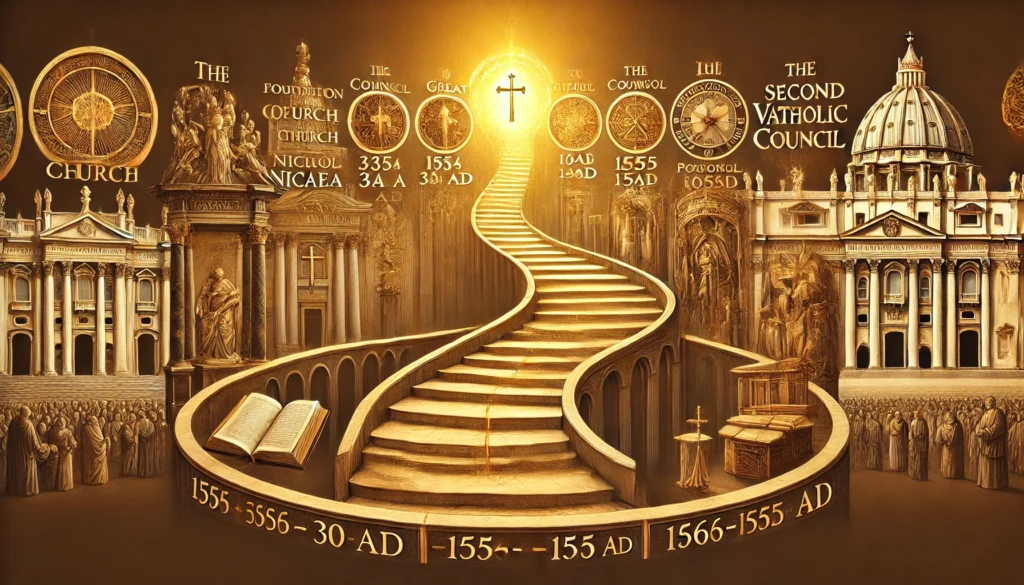
Catholic History
Catholicism, the largest Christian denomination, traces its origins to Jesus Christ and has evolved over centuries through various historical, theological, and cultural developments. Below is a structured timeline detailing its growth, divine purpose, mission, and vision.
1. The Foundations of Catholicism (c. 30–313 AD) – The Apostolic Era and Early Church
Key Events:
- c. 30 AD – Jesus Christ establishes His Church, appointing Peter as the first leader (Matthew 16:18).
- c. 33 AD – Pentecost marks the birth of the Church, as the Holy Spirit descends upon the Apostles (Acts 2).
- c. 50 AD – The Council of Jerusalem establishes that Gentiles can join the Church without following Jewish law.
- c. 64–67 AD – Martyrdom of St. Peter and St. Paul under Emperor Nero.
- c. 100 AD – The last Apostle, John, dies, marking the end of the Apostolic Age.
- c. 313 AD – Emperor Constantine issues the Edict of Milan, granting Christianity legal status in the Roman Empire.
Divine Purpose:
- To spread the teachings of Jesus Christ and establish the foundations of Christian doctrine.
Divine Mission:
- Evangelizing both Jews and Gentiles through apostolic preaching and scripture.
Divine Vision:
- To build a global community of believers who live according to the Gospel.
2. The Establishment of the Catholic Church (313–1054 AD) – The Imperial Church and Early Councils
Key Events:
- 325 AD – The First Council of Nicaea defines the Nicene Creed and affirms Christ’s divinity.
- 381 AD – The First Council of Constantinople confirms the Holy Trinity doctrine.
- 431 AD – The Council of Ephesus proclaims Mary as “Theotokos” (Mother of God).
- 451 AD – The Council of Chalcedon affirms Christ’s dual nature—fully divine and fully human.
- 590–604 AD – Pope Gregory the Great strengthens papal authority and liturgical practices.
- 800 AD – Pope Leo III crowns Charlemagne as Holy Roman Emperor, linking church and state.
- 1054 AD – The Great Schism divides the Church into Roman Catholicism (West) and Eastern Orthodoxy (East).
Divine Purpose:
- To establish unity in Christian doctrine and uphold the authority of the Church.
Divine Mission:
- Defining and defending Christian beliefs through councils and the authority of the Pope.
Divine Vision:
- To create a structured and universal Church that guides the faithful in truth and holiness.
3. The Medieval Catholic Church (1054–1517 AD) – Crusades, Monasticism, and Scholasticism
Key Events:
- 1096–1291 AD – The Crusades are launched to reclaim the Holy Land from Muslim rule.
- 12th–13th Century – The rise of monastic orders such as the Franciscans and Dominicans, emphasizing poverty and education.
- 1215 AD – The Fourth Lateran Council defines transubstantiation in the Eucharist.
- 1309–1377 AD – The Avignon Papacy, a period of papal exile in France.
- 1378–1417 AD – The Western Schism leads to multiple claimants to the papacy.
Divine Purpose:
- To defend Christianity, spread the Gospel, and provide moral leadership.
Divine Mission:
- Promoting Christian education, theological scholarship, and missionary expansion.
Divine Vision:
- A Church deeply engaged in spiritual and intellectual growth while remaining the moral compass of society.
4. The Catholic Reformation and Global Expansion (1517–1800 AD)
Key Events:
- 1517 AD – Martin Luther initiates the Protestant Reformation.
- 1545–1563 AD – The Council of Trent reforms Church practices and reaffirms Catholic doctrine.
- 1540 AD – The Jesuit Order (Society of Jesus) is founded to promote education and missionary work.
- 1600s–1700s AD – Catholic missions expand in the Americas, Africa, and Asia.
Divine Purpose:
- To preserve and restore Catholic unity in the face of the Protestant Reformation.
Divine Mission:
- Strengthening Catholic doctrine and increasing missionary outreach worldwide.
Divine Vision:
- A reinvigorated Church that remains a dominant spiritual and intellectual force.
5. The Modern Catholic Church (1800–Present) – Vatican Councils and Global Influence
Key Events:
- 1869–1870 AD – The First Vatican Council defines papal infallibility.
- 1917 AD – The Code of Canon Law is officially codified.
- 1962–1965 AD – The Second Vatican Council modernizes the Church, including the use of vernacular languages in liturgy.
- 1978–2005 AD – Pope John Paul II leads a global evangelization movement and contributes to the fall of communism.
- 2013 AD–Present – Pope Francis focuses on social justice, climate change, and interfaith dialogue.
Divine Purpose:
- To adapt the Church’s teachings to modern challenges while staying true to Christ’s mission.
Divine Mission:
- Engaging with the world through evangelization, charity, and interfaith dialogue.
Divine Vision:
- A Church that remains relevant and influential in guiding humanity toward faith, justice, and peace.
Conclusion
The Catholic Church has evolved over 2,000 years, remaining steadfast in its divine purpose, mission, and vision. Despite historical challenges, it continues to be a spiritual, moral, and social beacon for billions worldwide.

